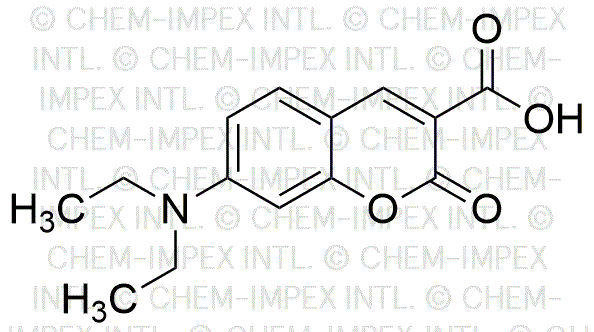7-(Diethylamino)coumarin-3-carboxylic acid is widely utilized in research focused on:
- Fluorescent Probes: This compound serves as a fluorescent marker in biological imaging, allowing researchers to visualize cellular processes in real-time.
- Photodynamic Therapy: It is used in cancer treatment where its fluorescent properties help in targeting and destroying cancer cells when activated by light.
- Analytical Chemistry: The compound is employed in the development of sensitive assays for detecting various biomolecules, enhancing the accuracy of laboratory tests.
- Drug Delivery Systems: Its unique chemical properties enable the design of effective drug carriers that can improve the bioavailability of therapeutic agents.
- Environmental Monitoring: The compound can be used to track pollutants in water systems, providing critical data for environmental protection efforts.
General Information
Properties
Safety and Regulations
Applications
7-(Diethylamino)coumarin-3-carboxylic acid is widely utilized in research focused on:
- Fluorescent Probes: This compound serves as a fluorescent marker in biological imaging, allowing researchers to visualize cellular processes in real-time.
- Photodynamic Therapy: It is used in cancer treatment where its fluorescent properties help in targeting and destroying cancer cells when activated by light.
- Analytical Chemistry: The compound is employed in the development of sensitive assays for detecting various biomolecules, enhancing the accuracy of laboratory tests.
- Drug Delivery Systems: Its unique chemical properties enable the design of effective drug carriers that can improve the bioavailability of therapeutic agents.
- Environmental Monitoring: The compound can be used to track pollutants in water systems, providing critical data for environmental protection efforts.
Documents
Safety Data Sheets (SDS)
The SDS provides comprehensive safety information on handling, storage, and disposal of the product.
Product Specification (PS)
The PS provides a comprehensive breakdown of the product’s properties, including chemical composition, physical state, purity, and storage requirements. It also details acceptable quality ranges and the product's intended applications.
Certificates of Analysis (COA)
Search for Certificates of Analysis (COA) by entering the products Lot Number. Lot and Batch Numbers can be found on a product’s label following the words ‘Lot’ or ‘Batch’.
Número de catálogo
Número de lote/lote
Certificates Of Origin (COO)
This COO confirms the country where the product was manufactured, and also details the materials and components used in it and whether it is derived from natural, synthetic, or other specific sources. This certificate may be required for customs, trade, and regulatory compliance.
Número de catálogo
Número de lote/lote
Safety Data Sheets (SDS)
The SDS provides comprehensive safety information on handling, storage, and disposal of the product.
DownloadProduct Specification (PS)
The PS provides a comprehensive breakdown of the product’s properties, including chemical composition, physical state, purity, and storage requirements. It also details acceptable quality ranges and the product's intended applications.
DownloadCertificates of Analysis (COA)
Search for Certificates of Analysis (COA) by entering the products Lot Number. Lot and Batch Numbers can be found on a product’s label following the words ‘Lot’ or ‘Batch’.
Número de catálogo
Número de lote/lote
Certificates Of Origin (COO)
This COO confirms the country where the product was manufactured, and also details the materials and components used in it and whether it is derived from natural, synthetic, or other specific sources. This certificate may be required for customs, trade, and regulatory compliance.


